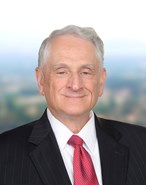Insurance/Reinsurance – Insurance Companies Emerge from Bank-Like Oversight
Publication | 02.28.18
[ARTICLE PDF]
Shortly after being sworn into office, President Donald J. Trump set in motion a change that will likely alter regulation for the entire U.S. insurance industry.
Trump signed an executive order two weeks into his term instructing Treasury Secretary Steven Mnuchin to undo large parts of the Dodd-Frank Act, which was signed into law in 2010 in response to the 2008 financial crisis.
Mnuchin recently delivered, issuing guidance in a report that, among other things, said that the federal Financial Stability Oversight Council will be much less likely to treat non-bank companies that deal primarily with insurance as systemically important financial institutions (SIFI).
The SIFI designation, also known as “too big to fail,” grew out of the Obama administration’s reaction to the near- collapse of the financial system in 2008. Essentially, it means that a company’s operations were so intertwined with the financial system that its collapse could endanger the broader U.S. economy. It was first used on banks and then extended to a small group of non-bank institutions.
The reversal was expected. “I would have been surprised if the Trump administration had continued the Obama administration’s policy of subjecting certain large insurance companies to enhanced oversight by the Federal Reserve,” says Richard Liskov, senior counsel to Crowell & Moring’s Insurance/Reinsurance and Corporate groups and former deputy superintendent of the New York State Insurance Department (now the New York State Department of Financial Services).
The non-bank SIFI designation subjects an insurance company to additional oversight by the Federal Reserve as well as stricter capital requirements. It was prompted by the federal government’s $182 billion bailout of American International Group (see “How AIG Shed the SIFI Label,” below).
Now, nearly a decade after the financial crisis, a SIFI change directly affects just two insurers: Prudential Financial and MetLife. But, as Liskov notes, “it portends less federal regulation of insurance generally.”
MetLife, which was designated a SIFI in December 2014, successfully sought in court to have the label removed when U.S. District Court Judge Rosemary Collyer ruled in March 2016 that the FSOC was “fatally flawed” in its process designating MetLife a non-bank SIFI. On January 18, the Trump administration agreed to drop the appeal of Judge Collyer’s ruling, which its predecessor had filed in 2016.

|
“The [SIFI] designations are potentially confusing and detrimental because … the consumer has reason to believe that state regulation is insufficient.” |
THE RIGHT THING TO DO
Now that the administration has decided to accept the de-designation of MetLife by not prosecuting the appeal, Liskov expects Prudential to be de-designated as well. It is the appropriate move to make for another reason, he says. That’s because state regulators are perfectly capable of overseeing insurance companies and don’t need any help from the Federal Reserve. Periodic on-site exams, annual risk-based capital measures, restrictions on investments, and independent audits by certified public accountants are “among the numerous tools that state insurance regulators have for monitoring the solvency of the insurance companies,” Liskov says.
Additionally, state regulators, because of their long experience with insurers, are better acquainted with their operations. For instance, New Jersey has been overseeing Prudential for more than a century. Liskov says one of the weaknesses of the non-bank SIFI rules is that they don’t require the Federal Reserve to accede to any objections from the state regulators tasked with overseeing insurance companies. He adds that the only way a SIFI designation would make sense is if the Dodd-Frank treatment applied to non-insurance operations while state insurance regulators handled the rest.
SENDING THE WRONG MESSAGE
There are further problems with the non-bank SIFI labels. “The designations are potentially confusing and detrimental because, to the extent it is being regulated by both the state and federal governments, the consumer has reason to believe that state regulation is insufficient,” Liskov says. “It erodes confidence in state insurance regulators as being protectors of consumers’ interest.”
The confusion doesn’t stop there. An insurer bearing the SIFI designation “can be viewed unfairly as having an advantage in the marketplace and lead to harmful expectations on the part of the consumer and companies that deal with SIFI companies that the federal government will do whatever it can to bail them out,” Liskov says. Making that perception even more off base is the fact that the federal government doesn’t have a specific fund set up to cover claims against insurance companies.
So the removal of non-bank SIFI designations should essentially be a vote of confidence from the Trump administration in state regulators. As Liskov notes, “It would be a reaffirmation that insurance in the U.S.—except for certain narrow categories such as flood, terrorism, and crops—should be regulated at the state level.”
Finally, Liskov says that the position Treasury has adopted appropriately recognizes the lead role of state insurance regulation, particularly in the view that SIFI designations should be made on the basis of what a company does, not what kind of company it is. “Before the federal government designates an insurance company as a SIFI, there needs to be full consultation with concerned state insurance regulators,” he says.
INTERNATIONAL IMPLICATIONS
Scrapping the non-bank SIFI label should also help quiet broader concerns about the U.S. insurance industry’s having to adhere to tough international standards. The Federal Reserve and the Treasury Department have been in talks with officials from other countries that regulate insurers and banks. Liskov says U.S. insurance companies fear the federal government is willing to acquiesce and follow the international standards that treat banks and insurance companies the same, requiring stiffer capital standards for insurers.
The U.S. insurance industry and state insurance regulators both argue that there is a big difference, and, notes Liskov, correctly so. “You can’t call up MetLife and say, ‘Give me back my money,’” he says. “These are not deposit institutions.”
So the administration’s decision to end virtually all non-bank SIFI designations for insurers should not only put state regulators back in charge, Liskov says, it should also signal to the international community that the U.S. will regulate insurance companies and banks differently—and be a welcome relief to U.S. insurers. Says Liskov: “The way that regulators monitor their solvency should be different from the way bank examiners look at the solvency of deposit institutions.”
HOW AIG SHED THE SIFI LABELThe insurer that started it all won’t even be affected by the Trump administration’s dropping the non-bank SIFI designation. American International Group was the first company to be designated a non-bank systemically important financial institution after its near-collapse forced a $182 billion bailout by the federal government. On September 29, 2017, AIG slipped the surly bonds of the SIFI badge when the Financial Stability Oversight Committee ruled it no longer deserved the designation because its performance no longer posed a risk to the U.S. economy. AIG was one of four non-bank SIFIs. General Electric shed the designation when it sold off most of its GE Capital arm. In 2015, MetLife successfully argued in court that it no longer deserved the designation, and the Justice Department recently dropped its appeal in that case. Prudential Financial is still trying to shake its SIFI label. Crowell & Moring’s Richard Liskov says that while MetLife and Prudential don’t deserve the SIFI label, there was a stronger argument for SIFI oversight of AIG before it sold off assets and fully repaid the U.S. government. |
Insights
Publication | May 25-27, 2008
“ISI mitigation using bit-edge equalization in high-speed backplane data transmission,” in IEEE International Conference on Communications, Circuits and Systems (ICCCAS 2008), pp. 589 - 593.
Publication | 04.18.24
Publication | 04.16.24
Rochester, NY, Diocese's Creditors To Mull Rival Ch. 11 Plans


